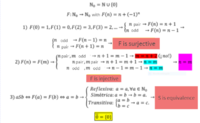tatibarrera231
New member
- Joined
- May 11, 2021
- Messages
- 8
I have a few questions regarding functions, it's kinda urgent hope you can help me understand;
Consider N0->N0 as the set of naturals including 0; that is, N0=N∪{0}, and consider the function: N0→N0, defined by F(n)=n+(−1)^ n.
Here ill leve my thoughts for know:
1.so for the first one, I think it is surjective cause it does have the same range and codomain, both being in the naturals including 0, but when you justify this analytically you have to clear x and that's where my main problem is cause I don't know how to(cause of the -1 elevated to n).
2.the same problem here I do think it's injective cause it only touches on one point of the graphic, but again analytically I'm not sure how to justify cause your spoused to do: f(a)=f(b)=> a=b, a+(−1)a=b+(−1)b, but again I'm not sure how to simplify it cause of the -1 elevated to n.
3.this one I completely don't know how to do
And correct me if I'm wrong, cause it's totally possible, and any help is greatly appreciated.
Hope you guys can help me.
#Functions #HelpMe! #Advice #Math #Urgent #Please
Consider N0->N0 as the set of naturals including 0; that is, N0=N∪{0}, and consider the function: N0→N0, defined by F(n)=n+(−1)^ n.
- Is F surjective?
- Is F injective?
- Consider the following S relation in N0×N0. ∀a,b∈N0,
[aSb]⟺F(a)=F(b)
Show that S is an equivalence relation on N0, and determine the equivalence class of a=0.
Here ill leve my thoughts for know:
1.so for the first one, I think it is surjective cause it does have the same range and codomain, both being in the naturals including 0, but when you justify this analytically you have to clear x and that's where my main problem is cause I don't know how to(cause of the -1 elevated to n).
2.the same problem here I do think it's injective cause it only touches on one point of the graphic, but again analytically I'm not sure how to justify cause your spoused to do: f(a)=f(b)=> a=b, a+(−1)a=b+(−1)b, but again I'm not sure how to simplify it cause of the -1 elevated to n.
3.this one I completely don't know how to do
And correct me if I'm wrong, cause it's totally possible, and any help is greatly appreciated.
Hope you guys can help me.
#Functions #HelpMe! #Advice #Math #Urgent #Please

